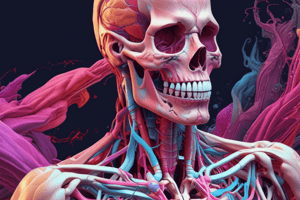Podcast
Questions and Answers
What is the main function of the skeletal system?
What is the main function of the skeletal system?
- Facilitates gas exchange
- Provides structure, support, and protection (correct)
- Transports nutrients and waste products
- Regulates bodily functions through hormones
Which system is primarily responsible for regulating body functions via hormone production?
Which system is primarily responsible for regulating body functions via hormone production?
- Endocrine System (correct)
- Nervous System
- Urinary System
- Respiratory System
Which of the following describes the function of the digestive system?
Which of the following describes the function of the digestive system?
- It breaks down food for nutrient absorption. (correct)
- It supports and binds other tissues.
- It facilitates gas exchange in the lungs.
- It eliminates waste from the body.
Which directional term refers to the front of the body?
Which directional term refers to the front of the body?
What is contained within the dorsal cavity?
What is contained within the dorsal cavity?
What separates the thoracic cavity from the abdominopelvic cavity?
What separates the thoracic cavity from the abdominopelvic cavity?
Which type of tissue covers body surfaces and lines cavities?
Which type of tissue covers body surfaces and lines cavities?
Which organ is NOT part of the urinary system?
Which organ is NOT part of the urinary system?
Flashcards are hidden until you start studying
Study Notes
Human Anatomy
Overview
- Study of the structure and organization of the human body.
- Comprised of various systems that work together to maintain homeostasis.
Major Organ Systems
-
Skeletal System
- Composed of bones, cartilage, ligaments.
- Provides structure, support, and protection; facilitates movement.
-
Muscular System
- Includes skeletal, smooth, and cardiac muscles.
- Responsible for movement, posture, and heat production.
-
Nervous System
- Divided into central (brain and spinal cord) and peripheral (nerves).
- Controls body functions, processes sensory information, and coordinates responses.
-
Circulatory System
- Composed of heart, blood vessels, and blood.
- Transports oxygen, nutrients, hormones, and waste products.
-
Respiratory System
- Includes lungs, trachea, bronchi.
- Facilitates gas exchange (oxygen in, carbon dioxide out).
-
Digestive System
- Comprises the gastrointestinal tract and accessory organs (liver, pancreas).
- Breaks down food for nutrient absorption and waste elimination.
-
Endocrine System
- Consists of glands (e.g., thyroid, adrenal).
- Regulates bodily functions through hormone production.
-
Urinary System
- Includes kidneys, ureters, bladder, and urethra.
- Eliminates waste, regulates blood volume and pressure, balances electrolytes.
-
Reproductive System
- Male: testes, prostate, penis.
- Female: ovaries, uterus, vagina.
- Responsible for reproduction and hormone secretion.
-
Integumentary System
- Composed of skin, hair, nails, and glands.
- Protects body, regulates temperature, and provides sensory information.
Anatomical Terminology
-
Planes of the Body:
- Sagittal: divides body into left and right.
- Frontal (Coronal): divides body into anterior and posterior.
- Transverse: divides body into superior and inferior.
-
Directional Terms:
- Anterior (ventral): front of the body.
- Posterior (dorsal): back of the body.
- Superior: above; inferior: below.
- Medial: toward the midline; lateral: away from the midline.
Body Cavities
-
Dorsal Cavity:
- Cranial cavity (houses the brain).
- Spinal cavity (contains the spinal cord).
-
Ventral Cavity:
- Thoracic cavity (houses heart and lungs).
- Abdominopelvic cavity (contains digestive organs, bladder, reproductive organs).
Histology
- Study of tissues:
- Epithelial tissue: covers body surfaces and lines cavities.
- Connective tissue: supports and binds other tissues.
- Muscle tissue: responsible for movement.
- Nervous tissue: transmits nerve impulses.
Developmental Anatomy
- Studies the formation and development of the body from conception to maturity.
- Includes embryology, which focuses on the first eight weeks of development.
Clinical Applications
- Understanding human anatomy is crucial for fields like medicine, nursing, and physical therapy.
- Anatomical knowledge is applied in diagnostics, surgery, and treatment planning.
Overview of Human Anatomy
- Structure and organization of the human body, focused on how various systems work to maintain homeostasis.
Major Organ Systems
- Skeletal System:
- Comprised of bones, cartilage, and ligaments; serves structural support, protection, and aids in movement.
- Muscular System:
- Includes three muscle types: skeletal, smooth, and cardiac; essential for movement, maintaining posture, and generating heat.
- Nervous System:
- Central (brain and spinal cord) and peripheral (nerves) divisions; critical for controlling body functions and processing sensory information.
- Circulatory System:
- Made up of the heart, blood vessels, and blood; responsible for transporting oxygen, nutrients, hormones, and waste products.
- Respiratory System:
- Comprises the lungs, trachea, and bronchi; vital for gas exchange—bringing in oxygen and removing carbon dioxide.
- Digestive System:
- Consists of the gastrointestinal tract and accessory organs like the liver and pancreas; functions to break down food and absorb nutrients.
- Endocrine System:
- Composed of various glands including the thyroid and adrenal glands; regulates bodily functions through hormone secretion.
- Urinary System:
- Contains kidneys, ureters, bladder, and urethra; key for waste elimination, blood volume and pressure regulation, and electrolyte balance.
- Reproductive System:
- Male includes testes and prostate; female composed of ovaries and uterus; essential for reproduction and hormone production.
- Integumentary System:
- Made up of skin, hair, nails, and glands; protects the body, regulates temperature, and provides sensory feedback.
Anatomical Terminology
- Planes of the Body:
- Sagittal: divides body into left and right; frontal (coronal): anterior and posterior parts; transverse: superior and inferior sections.
- Directional Terms:
- Anterior (ventral): front; posterior (dorsal): back; superior: above; inferior: below; medial: toward midline; lateral: away from midline.
Body Cavities
- Dorsal Cavity:
- Contains the cranial cavity housing the brain and the spinal cavity with the spinal cord.
- Ventral Cavity:
- Thoracic cavity houses heart and lungs; abdominopelvic cavity contains digestive organs, bladder, and reproductive organs.
Histology
- Study of tissues including:
- Epithelial Tissue: covers surfaces and lines cavities.
- Connective Tissue: supports and binds various tissues.
- Muscle Tissue: drives movement.
- Nervous Tissue: transmits nerve impulses.
Developmental Anatomy
- Focuses on body formation from conception to maturity, including embryology which examines the initial eight weeks of development.
Clinical Applications
- Fundamental knowledge of human anatomy is essential in fields such as medicine, nursing, and physical therapy, with application in diagnostics, surgeries, and treatment strategies.
Studying That Suits You
Use AI to generate personalized quizzes and flashcards to suit your learning preferences.





